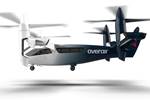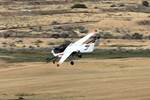Overair completes assembly of full-scale Butterfly eVTOL vehicle prototype
Overair heads to flight testing in early 2024, marked by rapid prototype development.
Overair employees celebrate the completion of their first full-scale prototype. Photo Credit: Overair
Overair (Santa Ana, Calif., U.S.) an advanced air mobility (AAM) company, has completed the assembly of the first full-scale prototype of its Butterfly all-electric vertical takeoff and landing (eVTOL) aircraft, which integrates a composites-intensive design. This marks a pivotal milestone for the OEM following the validation of its full-scale propulsion technology via a 2022 truck-based test. Following this announcement, Overair will begin vehicle-level testing phase at its Santa Ana headquarters, before moving the aircraft to the company’s expansive flight test facility in Victorville, California.
Initial tests, scheduled to begin in early 2024, will focus on validating Butterfly’s propulsion systems, flight control mechanics, safety features and operational efficiency. The testing will also assess the aircraft’s 55-decibel noise target and performance envelope across diverse flight and weather conditions.
“Assembling our first full-scale prototype vehicle marks the culmination of years of industry expertise, meticulous development planning, innovative engineering and the hard work of the entire Overair team,” Ben Tigner, CEO of Overair, says. “This seamless transition from propulsion testing to a full-scale prototype underscores our dedication to redefining the eVTOL landscape with safer, quieter and more reliable aircraft.”
Born out of Karem Aircraft, Overair is leveraging decades of VTOL expertise to efficiently develop, manufacture, test and refine its vehicle as it pursues certification and operation designed to match the Federal Aviation Administration’s (FAA) Advanced Air Mobility Implementation Plan. Overair claims that Butterfly will be the first eVTOL aircraft to be built around optimum speed tilt rotor (OSTR) and individual blade control (IBC) technologies.
OSTR technology varies propeller rpm to increase efficiency across vertical, transition and forward flight phases and can reduce power demand at hover by 60%. IBC reduces vibration and propeller loads, enhances safety, provides smoother ride quality and lowers maintenance costs. Together, these technologies are meant to deliver an efficient, quiet and reliable propulsion system in almost any weather, temperature or altitude. Additionally, the concept means fewer moving parts than traditional tiltrotors and no single points of failure, Overair says.
Butterfly features four oversized rotors, a spacious cabin, high payload, and quiet and efficient operation. The aircraft will be well suited for passenger, medical, cargo and military applications.
Overair is also focused on preparing for future operations. The company says it has attracted significant market interest from customers both in commercial as well as military and across several geographies, leading to a deep understanding of the product-market fit, including the recent announcement of an SBIR award by the U.S. Navy to further advance the IBC system.
Related Content
-
On the radar: Innovations in composite battery enclosures
A look at recently reported design, material and process innovations for composites-intensive battery enclosures, developed to support the ramp-up of EV and AAM vehicles.
-
Joby flies two eVTOL aircraft simultaneously in testing milestone
The latest in the company’s flight testing program targets certification testing acceleration and support of its passenger-carrying goals by 2026.
-
Lilium launches M&A process, targets eVTOL program continuation
Despite court-approved insolvency filings and beginning first investor briefings, Lilium remains fully focused on re-emerging following restructuring, setting its sights on fresh investment to support the Lilium Jet.

















